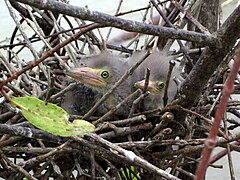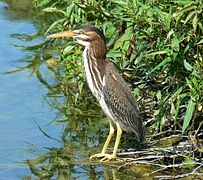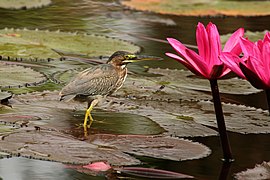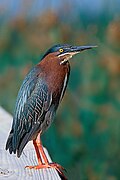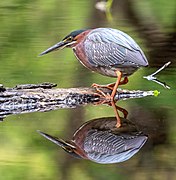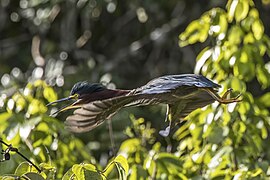Green heron
| Green heron Temporal range:
| |
|---|---|

| |
| Green heron have iridescent green feathers on their wings | |
| Call | |
| Scientific classification | |
| Domain: | Eukaryota |
| Kingdom: | Animalia |
| Phylum: | Chordata |
| Class: | Aves |
| Order: | Pelecaniformes |
| Family: | Ardeidae |
| Genus: | Butorides |
| Species: | B. virescens
|
| Binomial name | |
| Butorides virescens | |

| |
| Range ofB. virescens Breeding range Year-round range Wintering range
| |
| Synonyms | |
|
Ardea virescensLinnaeus, 1758 | |
Thegreen heron(Butorides virescens) is a smallheronofNorthandCentral America.Butoridesis fromMiddle Englishbutor"bittern" andAncient Greek-oides,"resembling", andvirescensisLatinfor "greenish".[2]
It was long consideredconspecificwith itssister speciesthestriated heron(Butorides striata), and together they were called "green-backed heron".Birds of thenominate subspecies(no matter whichtaxonomicarrangement is preferred) are extremely rare vagrants to westernEurope—for example, a sighting inPembrokeshirein 2018 was only the second recorded sighting inWales;[3]individuals from thePacificcoast of North America may similarly stray as far asHawaii.[4][5][6]
Description
[edit]The green heron is relatively small; adult body length is about 44 cm (17 in). The neck is often pulled in tight against the body. Adults have a glossy, greenish-black cap, a greenish back and wings that are grey-black grading into green or blue, achestnutneck with a white line down the front, grey underparts and short yellow legs. The bill is dark with a long, sharp point. Female adults tend to be smaller than males, and have duller and lighter plumage, particularly in the breeding season. Juveniles are duller, with the head sides, neck and underparts streaked brown and white, tan-splotched back andwing coverts,and greenish-yellow legs and bill. Hatchlings are covered indown feathers,light grey above, and white on the belly.[4][5][6]
The green heron's call is a loud and suddenkyow;it also makes a series of more subduedkukcalls. During courtship, the male gives araah-rahhcall with wide-open bill, makes noisy wingbeats andwhoom-whoom-whoomcalls in flight, and sometimes callsroo-rooto the female before landing again. While sitting, anaaroo-aaroocourtship call is also given.[5][6]
Measurements:[7]
- Length:16.1–18.1 in (41–46 cm)
- Weight:8.5 oz (240 g)
- Wingspan:25.2–26.8 in (64–68 cm)
Taxonomy
[edit]As noted above, this species was formerly included inB. striata,which at that time was erroneously known asB. striatus.TheEarly PleistoceneB. validipes,whose fossil remains were discovered in Florida, might have been the ancestor of the green heron as the living species seems to replace the extinct relative in the fossil record.
Subspecies distinction is uncertain at best. The color variation between populations is less pronounced than between birds of the same population. Migratory populations are longer-winged than those resident year-round, but this cannot be used to delimit subspecies as it is quite obviously a consequence of differing habits and can be expected to undergoconvergent evolutionin unrelated populations of this species that just share the same habits. Thus, thoroughmolecular phylogeneticstudies would be required to resolve the question of subspecies delimitation.
The following subspecies are commonly listed, though the validity of most of them is seriously disputed:[4]
- Butorides virescens anthonyi(Mearns,1895)
- Breeds in the United States west of theRocky Mountains,south to northernBaja California Peninsula,Mexico.Some resident, most migrate to western Mexico in winter.
- Butorides virescens bahamensis(Brewster,1888)
- Bahamas.Resident.
- Butorides virescens frazari(Brewster, 1888)
- Southern Baja California Peninsula, Mexico. Resident.
- Southernmost US throughCentral Americato centralPanama,Caribbean.Resident.
- Breeds from southeasternCanadato central and southern US east of the Rocky Mountains. Winters from southernmost US to northernSouth America.
Much of the dispute hinges upon the distinctness of the Caribbean and Central American populations, the secondtaxonin this species to be described. To describe the two most extreme views, some authors assemble the bulk of the mainland population in thenominate subspeciesbut treat theparapatricpopulations as distinct subspecies, while others place all resident populations inmaculataand all migratory ones invirescens.
Ecology
[edit]
Thehabitatand foraging area of the green heron includes riparian zones, wetlands, ponds, and lakes, as well as human-made canals and ditches.[9]Green herons do not exhibit a particular preference fordiurnalornocturnalforaging, often engaging in both.[9]Shore-living individuals adapt to the rhythm of the tides.[citation needed]They mainly eat small fish, frogs and aquaticarthropods,but may take anyinvertebrateorvertebrateprey they can catch, including such animals likeleeches,earthworms,dragonflies,damselflies,waterbugs,grasshoppers,spiders,[10]crayfish,[11]prawns,[10]mice,otherrodents,lizards,tadpolesandsnakes.[11]Some of the many fish eaten are:minnows,sunfish,catfish,perch,eelsand, in urban areas,goldfish.[11]Green herons are intolerant of other birds – includingconspecifics– when feeding and are not seen to forage in groups. They typically stand still on shore or in shallow water or perch upon branches and await prey. They are able to hover briefly to catch prey.[4][5][6]Green herons have been observed using captured prey (e.g.mayflies) or other objects (bread, feathers) to "bait-fish" – using a lure on the water's surface to attract fish.[12]This bait-fishing behavior is common among herons.[12]
The northern population moves to its breeding ranges during March and April; near the northernmost limit of the green heron's range, breeding is well underway by the end of May. The migration to the winter quarters starts in September; by late October, the birds are absent from regions where they do not stay all year. At least the northward migration does not seem to be affected byglobal warming;birds appear in their breeding ranges at the same time they did 100 years ago.[4][6][13][14]
Individuals of non-migratory populations abandon their territories after breeding season to roam about the region. They may or may not return to the previous year's breeding location, depending on whether they found better habitat during these wanderings. In these populations, the breeding season is determined by rainfall and consequent prey availability.[4][5][6]
Green herons areseasonallymonogamous.The pairs form in the breeding range, after an intense courtship display by the males, who select the nesting sites and fly in front of the female noisily and with puffed-up head and neck plumage. They nest inforestandswamppatches, over water or in plants near water. Nests are a platform of sticks, often in shrubs or trees, sometimes on the ground. Locations intreesare preferred, with some nests built up to 20 m (66 ft) off the ground although heights of several meters are more common. Rarely, large numbers of these birds congregate inheronriesfor nesting.[4][5][6]
Theclutchis usually 2–6 pale green eggs,[5]which are laid in 2-day intervals (though the second egg may be laid up to 6 days later than the first).[15]After the last egg has been laid, both parentsincubatefor about 19–21 days until hatching, and feed the young birds.[16]The frequency of feedings decreases as the offspring nearfledging.The young sometimes start to leave the nest at 16 days of age, but are not fully fledged and able to fend for themselves until 30–35 days old. Sometimes – particularly in thetropicalparts of its range – the green heron breeds twice a year.[4][5][6]
Tool use
[edit]Green herons are one of the few species of bird known to use tools. In particular, they commonly use bread crusts, insects, or other items as bait. The bait is dropped onto the surface of a body of water to lure fish. When a fish takes the bait, the green heron then grabs and eats the fish.[17]
Gallery
[edit]-
Nestlings
-
Subadult retaining some juvenile plumage
-
Young adultB. v. virescens
-
Breeding plumage
-
Adult
-
Adult
-
Hunting in New York
-
in Guatemala
-
SubspeciesB. v. maculatawith neck extended
-
Juvenile, Glastonbury, CT USA
References
[edit]- ^BirdLife International(2012)."Butorides virescens".IUCN Red List of Threatened Species.2012.Retrieved26 November2013.
- ^Jobling, James A (2010).The Helm Dictionary of Scientific Bird Names.London: Christopher Helm. pp.81,402.ISBN978-1-4081-2501-4.
- ^"Rare green heron spotted in Llanmill, Pembrokeshire".BBC News.30 April 2018.Retrieved30 April2018.
- ^abcdefghJutglar, Francesc (1992): 33. Green-backed Heron.In:del Hoyo, Josep; Elliott, Andrew & Sargatal, Jordi (eds.):Handbook of Birds of the World(Volume 1: Ostrich to Ducks): 417, plate 28. Lynx Edicions, Barcelona.ISBN84-87334-10-5
- ^abcdefghCornell Lab of Ornithology."Green Heron".Retrieved2010-04-08.
- ^abcdefghDewey, T. & Butzbaugh, J. (2001): Animal Diversity Web:Butorides virescens.Retrieved 2008-FEB-12.
- ^"Green Heron Identification, All About Birds, Cornell Lab of Ornithology".www.allaboutbirds.org.Retrieved2020-09-26.
- ^ "ITIS Report:Butorides virescens".Integrated Taxonomic Information System.Retrieved28 August2014.
- ^abMoore, Amanda A.; Green, M. Clay; Huffman, David G.; Simpson, Thomas R. (2016)."Green Herons (Butorides virescens) in an Urbanized Landscape: Does Recreational Disturbance Affect Foraging Behavior?".The American Midland Naturalist.176(2): 222–233.doi:10.1674/0003-0031-176.2.222.JSTOR44840286.
- ^ab"Butorides virescens (Green Heron)"(PDF).The Online Guide to the Animals of Trinidad and Tobago.University of the West Indies.
- ^abc"Butorides virescens (Green heron)".Animal Diversity Web.
- ^abDavis Jr., William E.; Zickefoose, Julie (1998). "Bait-fishing by Birds: A Fascinating Example of Tool Use".Bird Observer.26(3): 139–143.
- ^ Henninger, W.F. (1906)."A preliminary list of the birds of Seneca County, Ohio"(PDF).Wilson Bulletin.18(2): 47–60.
- ^Ohio Ornithological Society (2004):Annotated Ohio state checklistArchived2004-07-18 at theWayback Machine.
- ^Cornell Lab of Ornithology."Green Heron".Retrieved2011-05-11.
- ^Seattle Audubon Society."Green Heron".Archived fromthe originalon 2016-03-04.Retrieved2010-04-08.
- ^"Green Heron Overview, All About Birds, Cornell Lab of Ornithology".www.allaboutbirds.org.Retrieved2022-05-22.
External links
[edit]- Butorides virescens– Green heron at Animal Diversity Web
- Green heron –Butorides virescens– USGS Patuxent Bird Identification InfoCenter
- Green heron at eNature.com
- Field Guide on Flickr
- "Butorides virescens".Integrated Taxonomic Information System.Retrieved9 February2006.
- YouTube video of a green heron fishing
- YouTube Video of a Green Heron drowning a frog before eating it!
- Bermuda Dept. of Environment and Natural Resources green heron page
- "Green-backed heron media".Internet Bird Collection.
- Green heron photo galleryat VIREO (Drexel University)
- Green heron species accountat Neotropical Birds (Cornell Lab of Ornithology)


